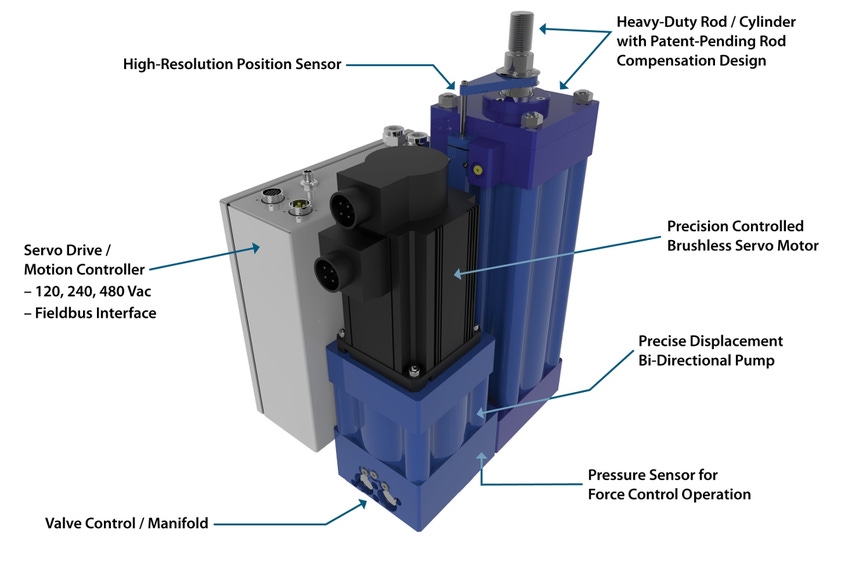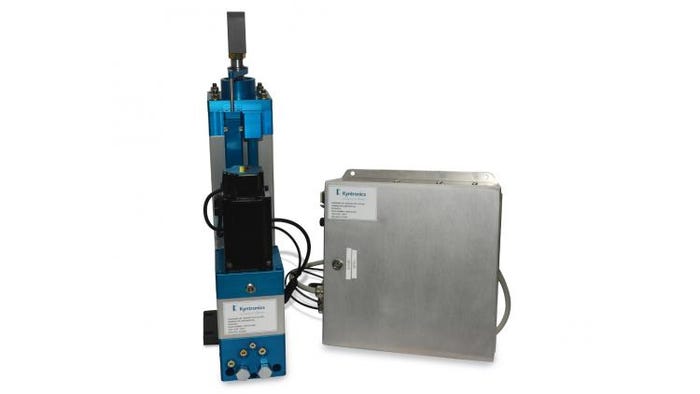Motion-control actuator combines advantages of electronics and hydraulics
August 9, 2018

Innovation in today’s packaging machinery often comes from the advanced design of its “smart” parts, including those for motion control. A new hydraulic actuator combines the power of standard hydraulic actuators with the speed and precision of electromechanical ones—all with easier installation, lower operating costs and less maintenance.
The Smart Hydraulic Actuator (SHA) from Kyntronics is an all-in-one piece of equipment that combines a variable-speed motor, a drive and a hydraulic cylinder—creating a new category of electro-hydraulic actuators.
It can deliver strokes of up to 120 inches at force capacities ranging up to 100,000 lbs. Its hydraulics are completely encapsulated, which avoids the problem of fluid contamination. The use of electronics makes the SHA connectible for the internet of things and other communication setups, while the lack of a brake and other mechanical components increases its durability.
While easily scalable, the system’s compact footprint and modularity (the power unit can be oriented as needed, for example) allow it to fit into small machine cavities. Additionally, its “power-on-demand” function—only running when needed—optimizes energy efficiency.
Carl Richter, vp and general manager of Kyntronics, talks with Packaging Digest about the USA-made SHA:
What are the major advantages of the SHA?
Richter: The SHA loads can vary from hundreds (fast) to many thousands (slower)of pound forces. Power is usually the limiting factor. The main contributors to power are load and speed. If one needs to double the speed (holding load constant), it takes twice the power. The same is true if speed was held constant and one needed to double the load: the power is 2x. At the lower loads, the SHA can perform fast, accurate indexes as desired, reducing cycle times while increasing reliability.
What kinds of packaging machinery would benefit from the use of the SHA?
Richter: There are many different machines which would like to take advantage of reduced cycle times: cartoning, conveyors, filling, handling (position control), labeling, packing, presses, wrapping and many more.
Can you give a range of cycle times for the SHA?
Richter: Cycle times vary depending on the actuator stroke, speed, duty cycle and process times. The machine builder controls the cycle times; the actuator is used to reliably reduce the cycle times as much as possible. The SHA can run 40+ inches per second depending on the loads. The key is running fast and accurately while minimizing downtime, which is where the SHA has a distinct advantage over other technology.

The modular unit combines a variable-speed motor, a drive and a hydraulic cylinder, and can be custom configured for specific needs.
Can you describe how the outer, low-pressure cylinder and the inner, high-pressure cylinder are configured within the device, and how this patent-pending mechanism works to deliver high force in a small footprint?
Richter: The outer pressure cylinder’s main purpose is to compensate for the differential volume from the rod side of the piston (high-pressure cylinder) compared to the load side of the piston. The fluid volume on both sides of the piston do not match due to the rod. There is less fluid on the rod side, so when fully retracted the oil needs to be stored somewhere, which is the low-pressure cylinder (with the closed cell foam).
********************************************************************************
Packaging solutions come to Minneapolis: As part of the region’s largest advanced design and manufacturing event, MinnPack 2018—and the five related shows taking place alongside it—brings 500+ suppliers, 5,000+ peers and 60+ hours of education together under one roof. Register for free today.
About the Author(s)
You May Also Like


